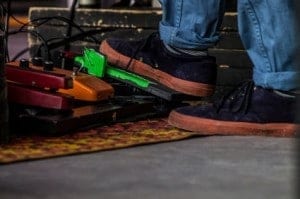Types of Guitar Effects Pedals
Within each class of guitar effects, there are multiple options you can choose from. For example, when it comes to distortion pedals, you can choose from labels including fuzz, overdrive and just plain distortion. But we also wanted to take a look at just the overall variety of pedals that are available to guitarists.

Sure, some experienced players may find the list a little rudimentary, but we hope it will be a helpful guide to beginners still finding their footing in the wide world of guitars and looking to see what options are available when it comes to expanding your tone.
Distortion Pedals
Probably the most common guitar effect, distortion pedals also have the widest variety of sounds available depending on which model you choose (and how you dial in your settings). The sound of the effect is pretty much right there in the name, though as mentioned before there are a slew of different types of distortion to choose from. We’ll go into these more in-depth in a separate article.
Delay Pedals
Delay and echo have been used since the earliest rock recordings, when a “slap back” echo was often employed on 50s rock tracks. Today, delay pedals whether analog or digital offer an extremely wide variety of options, from that classic slap back sound to extremely long delays to delays timed with the tempo of the song.
Chorus Pedals
As the name would suggest, these pedals attempt to make one guitar sound like multiple guitars. Depending on the pedal and the setting, this is achieved through duplicating the guitar signal and then slightly detuning and/or delaying it. Depending on its use, the effect can be used to fatten up a guitar sound or it can create a very “watery” guitar tone.
Flanger and Phaser Pedals
Upon first glance (well, first listen), flanger and phaser pedals can seem very similar, and though both are popular, individual guitarists tend to prefer one to the other. Flangers replicate the sound of two guitar signals being played at the same time -- one is the original while the other is sped up and slowed down as it plays. Phasers are slightly more subtle, and are meant to represent a rotating, side-to-side sound.
They both create moving and sweeping effects, and the best way to find out which best suits your needs is to compare both and see which works best for you and your sound.
Wah Pedal
Though it’s been well over 40 years since his death, the wah pedal is still most strongly associated with Jimi Hendrix, and likely forever will be. The pedal creates a, well, “wah” sound, and the extent of the effect is controlled by a foot pedal. Today, there also are auto-wah stompboxes that don’t require the active foot control, though many guitarists want to keep that control.
Other Pedals
There are tons of other types of effect boxes out there too, though this list represents the most popular. Other models include reverb, compressor, acoustic simulators, tremolo, EQ and filters, to name a few. As usual when it comes to guitar tone, which pedals you need depend completely on the specific tone you’re after, though it’s a great idea (and a lot of fun) to try out multiple pedals and combinations to see what sounds best for you.




